Unpacking the Link Between Toe Walking and Autism
Toe walking, a common gait pattern observed in young children, becomes a concern when it persists beyond the typical developmental window. Especially in children with autism spectrum disorder (ASD), toe walking can indicate underlying neurological and sensory processing differences. This article explores the relationship between toe walking and autism, causes, diagnosis, treatment options, and what caregivers need to know to support affected children effectively.
Prevalence and Significance of Toe Walking in Autism
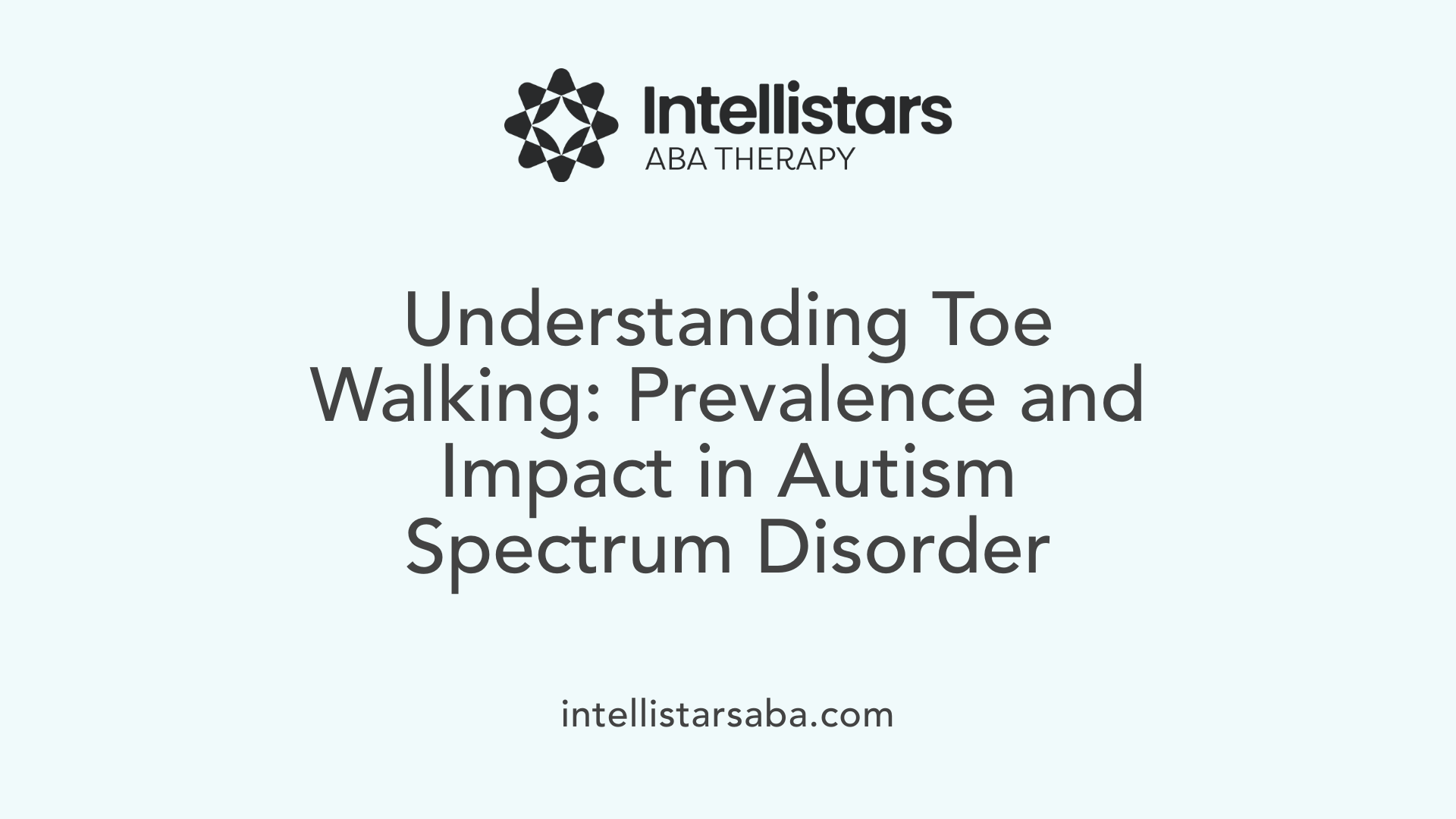
What is the relationship between toe walking and autism spectrum disorder (ASD)?
Toe walking is notably more common among children with ASD. Studies show that approximately 8-9% of autistic children exhibit persistent toe walking, which is significantly higher than the less than 0.5% observed in neurotypical children. This gait pattern can be linked to sensory processing differences, abnormalities in the vestibular system, muscle tone issues such as tight heel cords, and delays in motor development often seen in children with autism.
Research suggests that toe walking may serve as a primitive walking pattern or be related to archaic tonic reflexes rather than solely sensory processing problems. The behavior can be a reflection of underlying neurological or sensory integration issues associated with ASD.
Various treatments aim to address persistent toe walking, including physical therapy, casting, tendon lengthening surgeries, and visual-vestibular interventions like prism lenses. Early management is important, especially for children over five, where toe walking may be considered a sign of developmental concern.
How common is toe walking in children with autism compared to neurotypical children?
Children with autism are around eight times more likely to walk on their toes compared to their neurotypical peers. A large-scale study analyzing over 2 million children found that 8.4% of children with ASD also had persistent toe walking, in stark contrast to only 0.47% in typically developing children.
These figures highlight the strong association between ASD and toe walking. Children with autism often develop distinctive gait characteristics, including wide stance and variable stride lengths, possibly due to weaker knee muscles and motor control issues.
What are the long-term effects of persistent toe walking?
The long-term implications of persistent toe walking are still being studied. Some research links it to biomechanical changes such as limited ankle range of motion, which can cause balance problems, muscle weakness, and joint issues if left unaddressed.
However, other studies have found that toe walking does not necessarily lead to adverse physical consequences. Despite this, persistent toe walking can affect gait and posture, potentially impacting overall mobility and comfort.
Establishing early treatment plans—like physical therapy, stretching exercises, and in some cases, surgical interventions—can improve ankle mobility and reduce the risk of future complications. Overall, managing toe walking in children with ASD is vital to ensure healthy development and mobility.
| Aspect | Prevalence | Notes |
|---|---|---|
| In children with ASD | About 8-9% | Significantly higher than neurotypical peers |
| In neurotypical children | Less than 0.5% | Usually outgrows by age 2 |
| Gender differences | Higher in males | Reflects general autism prevalence |
| Treatment rates | Higher among ASD | Includes therapy, casting, and surgery |
Understanding the prevalence and implications of toe walking in autism underscores the importance of early assessment and intervention, supporting better motor development and quality of life for affected children.
Causes of Toe Walking in Children with Autism
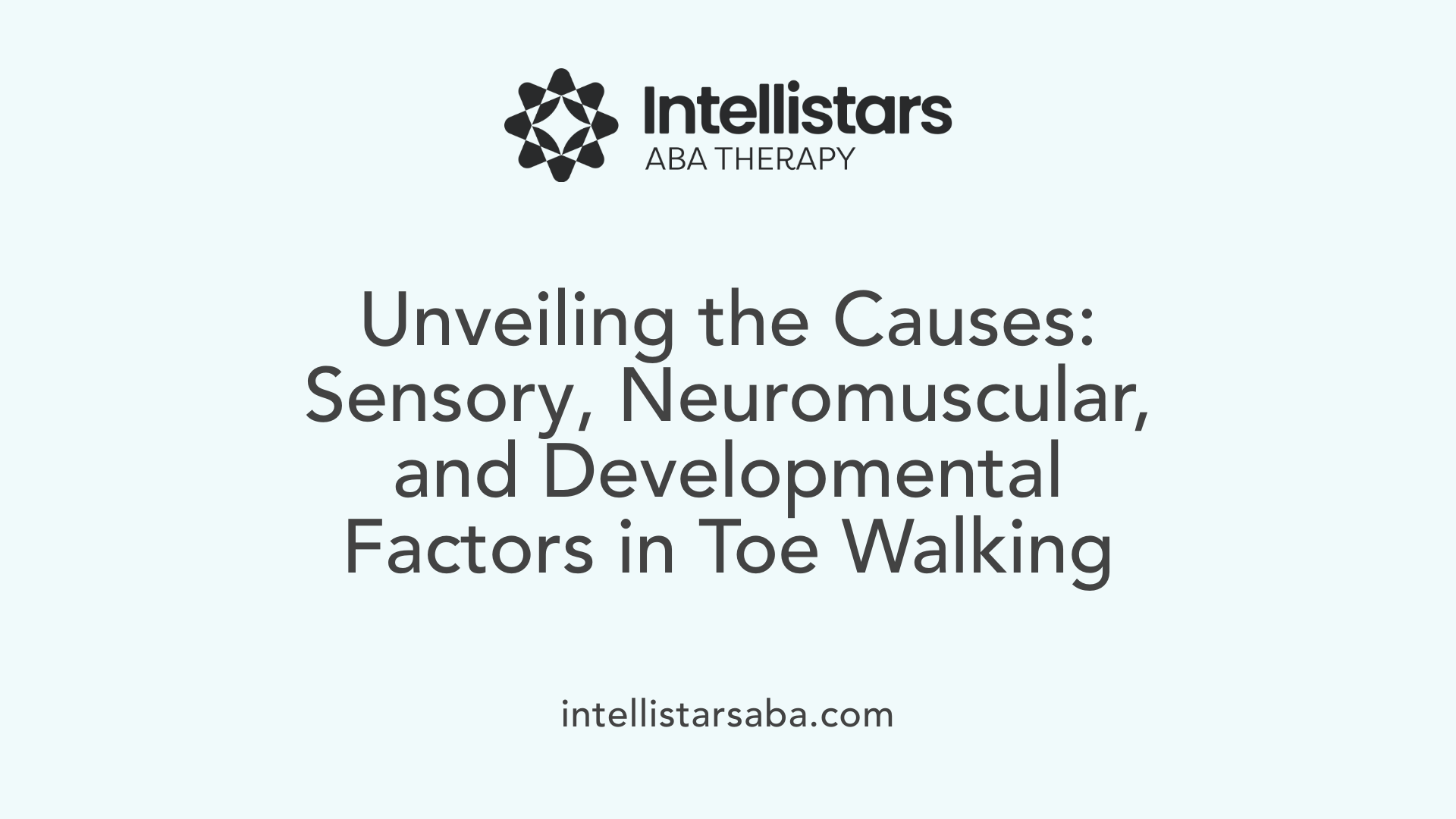
What are the causes of toe walking in children with autism?
In children with autism, toe walking often results from a mix of sensory processing differences and neuromuscular factors. One significant contributor is dysfunction within the vestibular system, which helps regulate balance and awareness of body position. Many children with autism experience vestibular system dysregulation, which can lead to gait abnormalities like persistent toe walking. This posture might serve as a compensatory response to sensory processing issues, especially those affecting balance and spatial orientation.
Another factor involves muscle tightness. Children with autism are more likely to have tight heel cords or Achilles tendons, which limit ankle movement and promote toe walking. These muscular restrictions can be tied to underlying neuromuscular development differences or elevated muscle tone, known as hypertonicity.
Developmental delays and primitive reflexes may also impact gait patterns. Toe walking can be a primitive walking style that persists due to ongoing neurological immaturity or delayed motor development. Some children enter a pattern of archaic tonic reflexes, which can interfere with typical heel-toe gait development.
Behavioral aspects may influence toe walking too. Severe autism-related symptoms, such as higher autism severity and motor impairments, are linked to increased persistence of toe walking. Sensory seeking or avoidance behaviors further complicate gait, with some children refusing to make contact with the ground due to tactile sensitivities.
Overall, these causes reflect an interconnected system involving sensory dysregulation, neuromuscular tightness, and developmental factors. This combination often sustains the toe walking pattern beyond the typical age of outgrowing it, usually around age three, highlighting the need for early evaluation and intervention.
Overview of causes
| Cause | Effect | Additional Notes |
|---|---|---|
| Sensory processing issues | Gait abnormalities, sensory avoidance behaviors | Often involves vestibular and tactile system dysregulation |
| Vestibular system dysfunction | Balance problems, primitive gait patterns | Common in ASD, impacts body awareness |
| Muscle tightness | Restricted ankle joint movement | Includes Achilles tendons and heel cords |
| Primitive reflexes | Persistence of archaic walking patterns | Delays in neurological maturation |
| Developmental delays | Motor planning difficulties | Contribute to atypical gait patterns |
Understanding these factors allows for targeted therapies that address both sensory and neuromuscular causes, improving mobility and gait in children with autism.
Methods for Diagnosing Toe Walking in Autistic Children
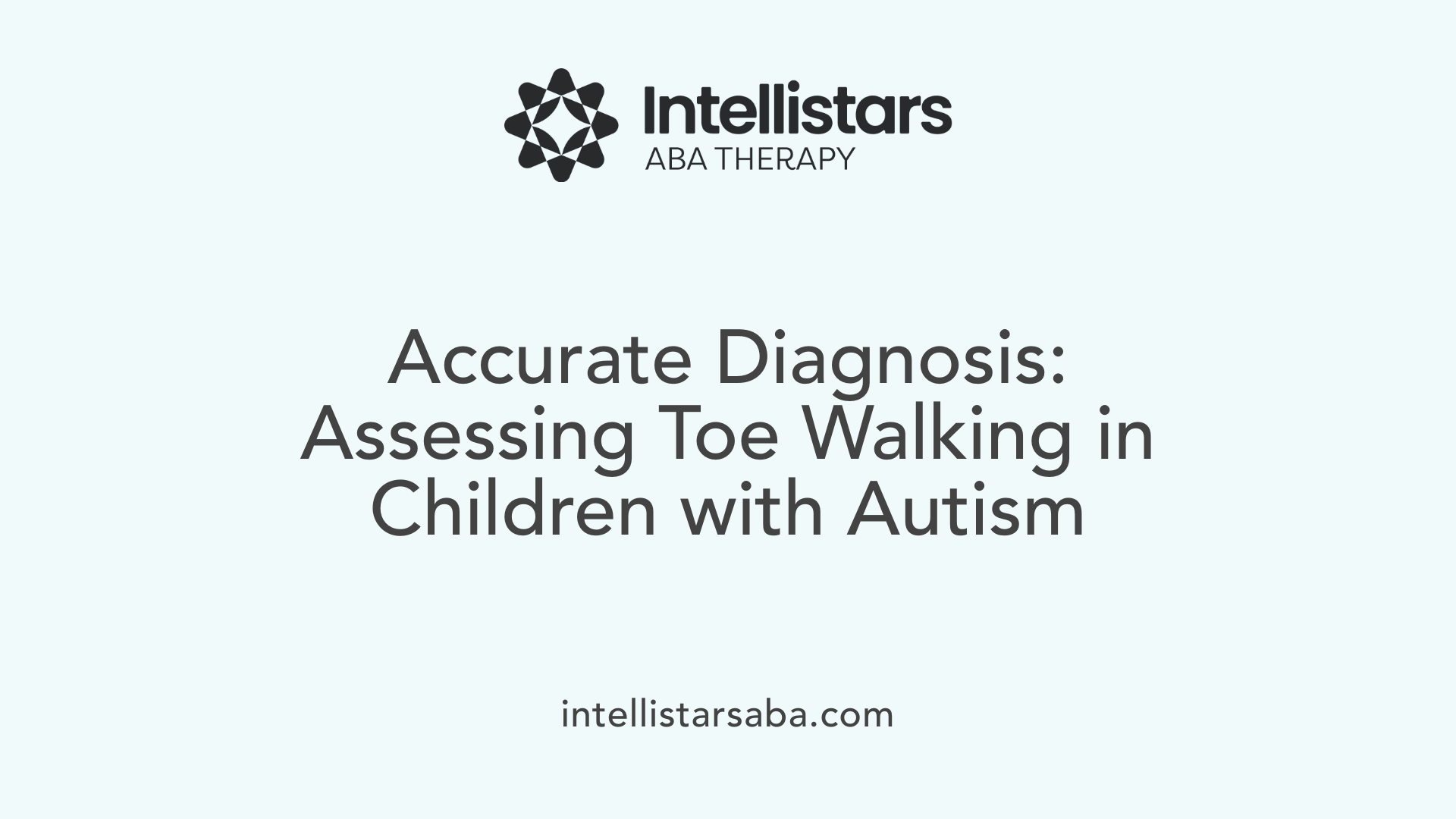
How is toe walking diagnosed in children with autism?
Diagnosing toe walking in children with autism involves a thorough clinical assessment conducted by healthcare professionals such as pediatricians, neurologists, or developmental specialists. The initial step is careful observation of the child's gait. Clinicians look for persistent walking on the toes or the balls of the feet beyond the typical age of two or three, which is when most children outgrow this pattern.
A crucial part of the diagnosis is ruling out other possible medical and neurological issues. Conditions like muscular dystrophy, cerebral palsy, or tight Achilles tendons can cause similar gait patterns, so physical examinations and neurological assessments are performed to exclude these causes.
Because toe walking can be linked with sensory processing challenges prevalent in autism, clinicians also evaluate the child's overall developmental, sensory, and behavioral profile. They may inquire about other signs of autism, such as language delays, social difficulties, or repetitive behaviors.
Further assessment may include observing the child's response to visual and vestibular stimuli. For example, since a dysfunctional vestibular system can contribute to abnormal gait patterns, tests of balance and spatial orientation can offer insights into underlying vestibular or visual-vestibular dysfunctions.
If persistent toe walking coincides with other signs of autism, a comprehensive developmental evaluation is recommended to confirm the diagnosis and plan appropriate interventions. These assessment methods together help ensure an accurate diagnosis, guiding effective treatment strategies.
Treatment and Intervention Strategies
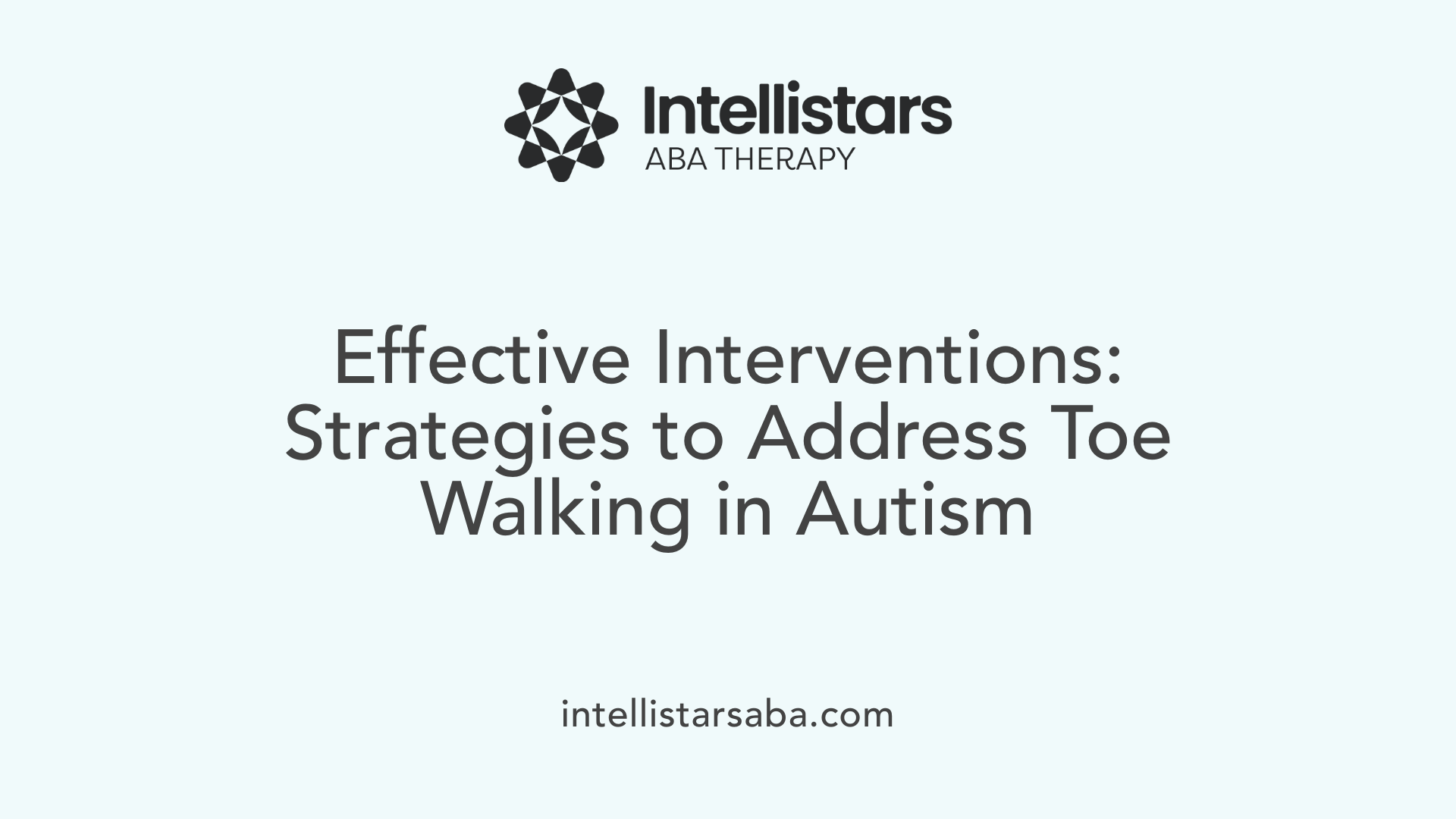
What treatment options are available for toe walking in children with autism?
Managing toe walking in children with autism involves a variety of approaches aimed at improving gait and addressing underlying muscular or sensory issues. One of the primary methods is physical therapy, which incorporates stretching and strengthening exercises to increase ankle dorsiflexion and reduce toe walking. Techniques such as bear crawls, heel walking, star jumps, and stork stands are commonly used to enhance stability, balance, and body awareness.
Sensory integration and vestibular stimulation are also critical components. Since a dysfunctional vestibular system is common in autism and may contribute to toe walking, therapies that stimulate balance and spatial orientation can help normalize gait patterns.
Orthotic devices, including braces, splints, or night splints, support proper foot placement and prevent abnormal walking postures. For more persistent cases, serial casting can gradually stretch the Achilles tendon, typically applied every two weeks over a span of 6-8 weeks. Additionally, Botox injections are used to relax tight calf muscles, facilitating easier stretching and movement.
In severe or resistant cases, surgical options such as tendon lengthening may be considered. These procedures aim to correct muscle tightness and improve ankle mobility, often combined with post-surgical physical therapy for optimal recovery.
One innovative approach is the 'Cast and Go' protocol, which combines botulinum toxin injections, serial casting, orthoses, and rehabilitative therapies. Studies have found this protocol effective for correcting ankle dorsiflexion to a neutral (90°) position in children with ASD, with success rates reaching 100% in some samples.
The choice of treatment is typically tailored to the individual, taking into account baseline ankle range of motion, severity of toe walking, and overall developmental status. Early intervention is particularly important, as it can help prevent secondary issues such as balance problems, muscle weakness, and joint deformities.
A multidisciplinary team—including physiotherapists, occupational therapists, neurologists, and family caregivers—plays a vital role in designing and implementing these interventions. Together, this team works to improve gait, address sensory processing differences, and support the child's motor development.
More information for search:
Treatment options for toe walking in ASD
Symptoms and Characteristics of Toe Walking in Autism
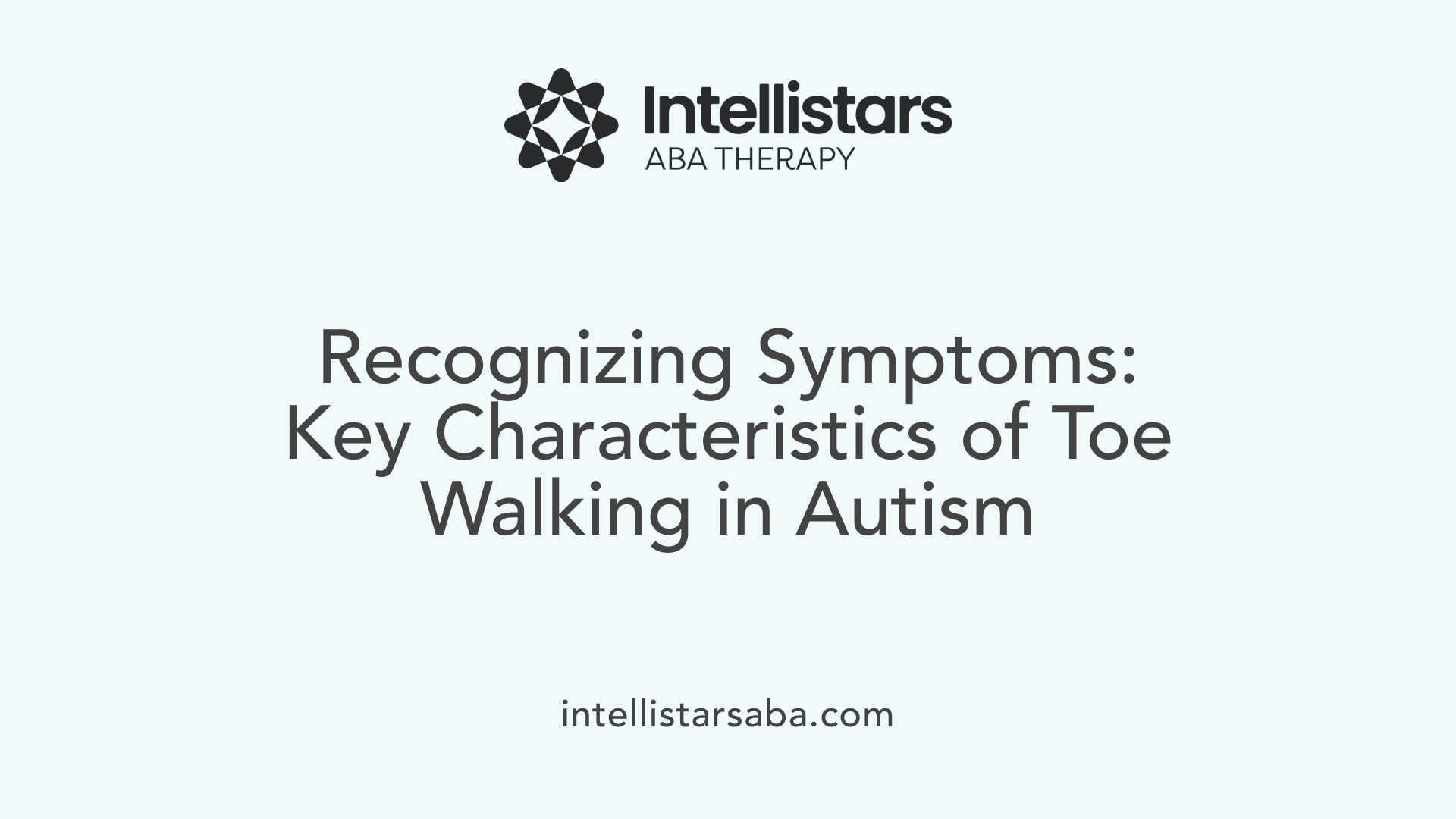
What are the characteristic symptoms of toe walking associated with autism?
In children with autism, toe walking often persists beyond the typical early childhood years, especially after age 2 or 3. Unlike in younger children where toe walking is common and usually temporary, persistent toe walking in older children can signal underlying developmental or neurological issues.
Children with autism who walk on their toes typically show reduced contact of the heel with the ground during gait. This pattern may involve walking on the balls of the feet or the toes themselves. Such gait abnormalities are often linked to dysfunctions in the sensory and vestibular systems, which affect balance, coordination, and motor planning.
In addition to the gait pattern, children with autism presenting toe walking may exhibit broader developmental features. These can include delays in speech development, repetitive behaviors, and sensitivities to sensory stimuli. Some may display issues with body awareness and motor control, making it difficult to perform tasks requiring coordination.
Research indicates that a dysfunction in the vestibular system, common in autism, plays a role in toe walking. Many affected children also experience heightened sensory sensitivities, including auditory and tactile sensitivities, which can further influence their movement patterns.
The presence of persistent toe walking often suggests more extensive motor and sensory processing challenges. This gait pattern may be part of a complex profile of signs that require multidisciplinary intervention.
Interventions aim to correct the gait to prevent long-term biomechanical issues such as muscle tightness, joint contractures, or imbalance. These can include physical therapy, stretching exercises, casting, night splints, or even surgical procedures like Achilles tendon lengthening.
In summary, persistent toe walking in children with autism is characterized by continued toe-only contact with the ground, often accompanied by sensory sensitivities and broader motor difficulties. Recognizing these signs early allows for targeted therapies to improve mobility, posture, and overall motor function.
Impacts, Outcomes, and Support Strategies for Caregivers
What are the potential long-term effects of persistent toe walking in children?
Persistent toe walking, especially beyond age 3, can lead to biomechanical issues such as limited ankle dorsiflexion, which may restrict normal foot and leg growth. Over time, it can cause muscular imbalances, joint stiffness, and changes in gait patterns that might result in balance problems or difficulty with walking. Some studies suggest that untreated toe walking might also contribute to poor posture and increased risk of injury.
Are there balance and muscle strength problems associated with this condition?
Children with ongoing toe walking often display weaker knee muscles and reduced ankle flexibility. This can impact overall coordination and stability, making everyday activities more challenging. In children with autism, these balance and muscle strength issues may be compounded by sensory sensitivities, further affecting their gait and body control.
What guidance should be given to parents and caregivers about managing toe walking?
Parents and caregivers need clear information that persistent toe walking after age 3 could be an indicator of underlying conditions such as autism spectrum disorder or muscular tightness, warranting professional assessment. Education should emphasize understanding that toe walking can result from sensory processing factors, muscular or neurological issues, and each child's needs are different.
Early intervention is crucial for better outcomes. Treatment options include physical therapy, stretching exercises, use of orthotics like night splints, and in some cases, medical procedures such as casting or surgery. Active parental involvement, supporting therapy exercises at home, and choosing appropriate footwear are essential to managing the condition effectively.
How effective is early intervention in improving toe walking outcomes?
Studies have shown that early treatment significantly enhances the chances of correcting toe walking, restoring ankle mobility, and preventing long-term deformities. Interventions like serial casting, botulinum toxin injections, and targeted physiotherapy have demonstrated high success rates, often achieving normal ankle dorsiflexion. The earlier these treatments begin, the better the potential for a full recovery, reducing the risk of future musculoskeletal complications.
| Aspect | Effect | Additional Details |
|---|---|---|
| Long-term biomechanical effects | Potential joint stiffness and gait issues | Untreated toe walking can affect foot and leg growth. |
| Balance and muscle strength problems | Reduced stability and coordination | Weaker knee muscles common in children with ASD. |
| Educational guidance for parents | Recognize signs and seek evaluation | Early diagnosis improves treatment success. |
| Effectiveness of early intervention | High success in correcting gait patterns | Interventions include stretching, casting, and therapy. |
| Common treatments | Physical therapy, casting, surgery | Tailored to individual needs and severity. |
Providing parents and caregivers with comprehensive guidance helps ensure early detection and effective management, minimizing long-term impacts and improving quality of life for children exhibiting persistent toe walking.
Insights from Scientific Research and Future Directions
Are there scientific insights into the underlying neurological basis of toe walking in autism?
Research indicates that toe walking in children with autism stems from various neurological and sensory factors. One aspect involves persistent primitive reflexes or archaic tonic reflexes, which can influence gait patterns and inhibit normal ankle dorsiflexion, leading to toe walking.
Additionally, abnormalities in muscle tone and motor planning are often observed. Some studies suggest that children with autism may experience dysfunctions within the vestibular system—the system responsible for balance and spatial orientation. This dysfunction can contribute to gait issues, including toe walking.
There is also evidence pointing to differences in sensory processing, especially relating to tactile and proprioceptive inputs. However, interestingly, studies have found no significant differences in sensory profiles between ASD children with and without toe walking, which suggests that sensory processing alone may not fully explain the behavior.
Furthermore, biomechanical factors such as tight Achilles tendons are common reasons for persistent toe walking. These physical conditions often require intervention through stretching, casting, or surgical procedures.
In summary, the neurological basis of toe walking in autism is multifaceted. It likely involves a complex interplay of primitive reflex persistence, vestibular and sensory system dysregulation, muscle tone abnormalities, and biomechanical factors. Understanding these underlying mechanisms can guide more targeted and effective treatments.
Research on sensory and motor integration
Investigations into sensory and motor integration reveal that deficits in processing sensory signals may impact motor responses, including gait. Yet, current data does not show significant sensory profile differences between those with ASD who walk on toes and those who do not.
This suggests that other elements, such as persistent primitive reflexes and vestibular dysfunctions, may have a more direct role in gait anomalies like toe walking.
Potential for non-invasive treatment approaches
Innovative, non-invasive interventions are being explored, including visual-vestibular therapies. For example, some research demonstrates that wearing prism lenses, which displace the visual field, can immediately reduce toe walking.
Other non-invasive approaches include physical therapy focusing on stretching exercises, balance and coordination training, and vestibular stimulation therapies aimed at improving sensory integration.
Implications for early diagnosis and intervention
Early identification of toe walking—particularly beyond age two—can serve as an indicator for further developmental assessment for autism or other conditions.
Interventions such as physical therapy and sensory integration techniques can be most effective when implemented early, potentially preventing biomechanical complications and supporting motor development.
In conclusion, a deeper understanding of the neurological and sensory mechanisms behind toe walking offers pathways for innovative treatments. It also underscores the importance of early screening and intervention strategies to support better developmental outcomes.
Supporting Children with Autism and Toe Walking
Understanding the multifaceted nature of toe walking in children with autism is crucial for effective management and intervention. Recognizing it as a symptom reflecting underlying sensory, neurological, and motor differences allows clinicians and caregivers to tailor approaches that promote optimal development. Early diagnosis and a multidisciplinary treatment strategy—encompassing physical therapy, sensory integration, and possibly surgical options—are key to improving gait, safety, and quality of life for affected children. Caregivers play an essential role in ongoing support and adherence to therapy plans, contributing to better long-term outcomes. Continued research into the neurological underpinnings of toe walking promises to refine treatment approaches further, offering hope for more targeted and non-invasive solutions.
References
- Toe Walking and Autism Spectrum Disorder
- What is Toe Walking? - Autism Research Institute
- The Management of Toe Walking in Children with Autism Spectrum ...
- Toe walking in children and adolescents with Autism Spectrum ...
- Does Autism Cause Walking On Your Toes? - Healthline
- Toe walking in children - Symptoms & causes - Mayo Clinic
- The Prevalence of Persistent Toe Walking in Children With and ...
- Understanding Toe Walking and Autism
- Toe Walking and ASD: What's the Connection? - Psych Central






